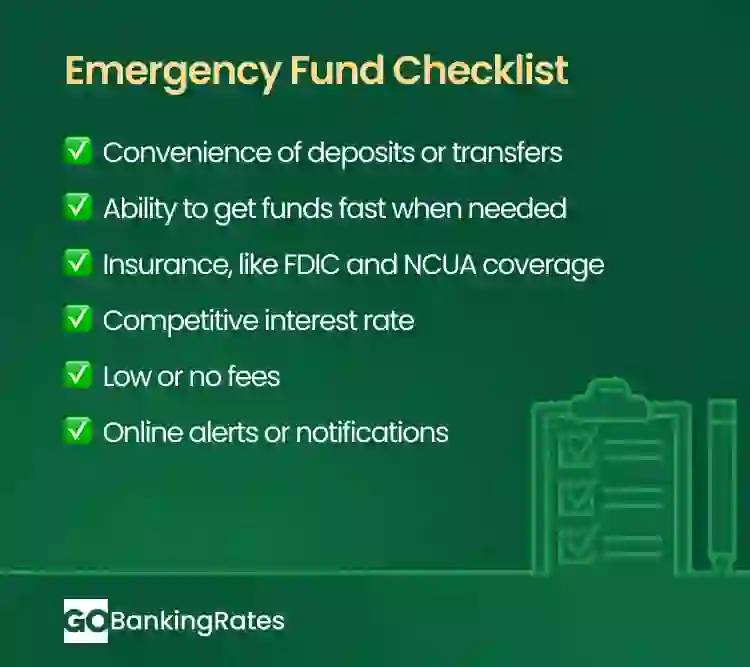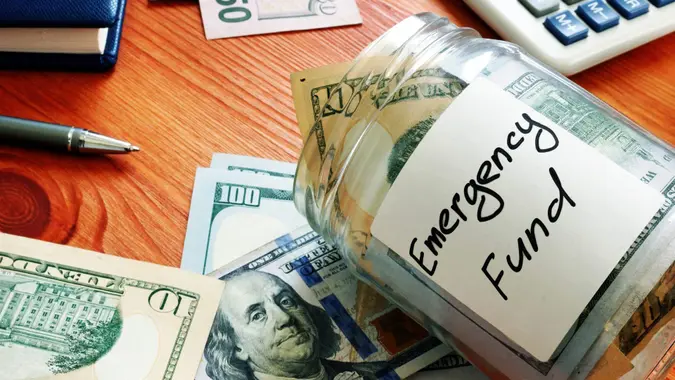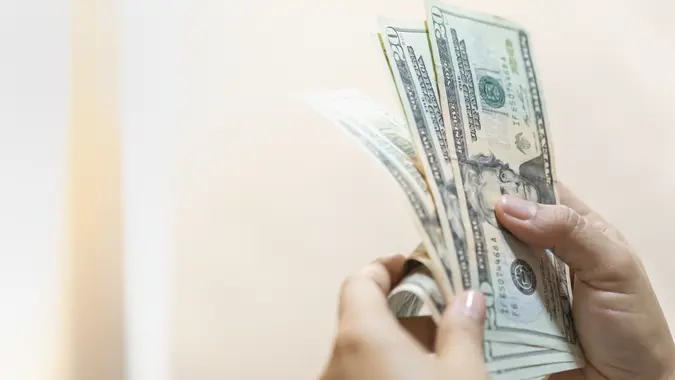Where To Keep Emergency Funds in 2025: 5 Top Options To Consider

Commitment to Our Readers
GOBankingRates' editorial team is committed to bringing you unbiased reviews and information. We use data-driven methodologies to evaluate financial products and services - our reviews and ratings are not influenced by advertisers. You can read more about our editorial guidelines and our products and services review methodology.

20 Years
Helping You Live Richer

Reviewed
by Experts

Trusted by
Millions of Readers
Having an emergency fund is an important part of financial security. Setting money aside in an account where you can easily access it will ensure that you can pay for an unexpected expense, like a medical bill or home repair. It’s important that the money be accessible, safe and earn some interest, too.
What To Look for in an Emergency Fund: Quick Checklist
Here are some things you want to look for when deciding where to keep your emergency fund.

5 Best Accounts To Keep Your Emergency Fund
The best accounts for your emergency fund will provide safety, accessibility and a decent interest rate.
1. High-Yield Savings Accounts (HYSA)
A high-yield savings account will give you one of the best interest rates with virtually no risk. Rates vary, and can change, so it helps to shop around and keep an eye on your rate.
| Pros | Cons |
|---|---|
| High interest rates | Highest rates may be at online banks |
| FDIC or NCUA insured, so you can’t lose your money | Rates can change |
| Typically easy to deposit and withdraw | There may be deposit limits |
2. Money Market Accounts (MMA)
Money market accounts combine the convenience of a checking account with the returns of a savings account. You can usually write checks on a money market account, but there may be a limit to the number you can write each month.
Because money market accounts are available from banks and credit unions, your savings will be insured up to the federal limit.
| Pros | Cons |
|---|---|
| Check writing may be available | The number of transactions may be limited |
| FDIC or NCUA insured | Watch out for fees |
3. Certificates of Deposit (CDs)
When considering where to put your emergency fund, a CD may not be the first thing that comes to mind. CDs are usually thought of for longer-term investments, because you choose the term when you open the account, and those terms can range from 30 days to 5 years or longer. If you withdraw your funds earlier, you may pay a penalty.
There are a couple of ways to use CDs for your emergency savings, however.
- Penalty-free CD: These CDs let you withdraw your money before the end of the term without paying an early withdrawal penalty. Not all banks and credit unions offer them, so be sure to check availability before opening an account.
- CD ladder: This approach involves purchasing multiple CDs with staggered maturity dates using portions of your emergency fund. For example, with a $50,000 fund, you could open a 6-month, 12-month, 2-year, 3-year and 4-year CD — depositing $10,000 in each. That way, you’ll have access to funds every few months without penalty, and you can reinvest matured CDs into longer terms to maintain steady access.
| Pros | Cons |
|---|---|
| Fixed interest rate for the entire term | There may be a penalty for early withdrawal |
| FDIC or NCUA insured | Longer-term CDs may have lower rates |
4. Standard Savings at Your Main Bank
You can, of course, keep your emergency fund in a standard savings account at your bank. This option provides easy access to your funds — you can withdraw money with your debit card if you need to. And your bank or credit union insures your funds through the FDIC or the NCUA, so your money will be safe.
What you may not get from a standard savings account is a competitive interest rate, although that’s not a given. Compare the rate at your bank with rates at online banks to see how they stack up.
| Pros | Cons |
|---|---|
| Convenience and familiarity | Interest rate may not be competitive |
| FDIC and NCUA insurance |
How Much Should Your Emergency Fund Be?
A good rule of thumb is to have three to six months’ worth of essential living expenses in your emergency fund. That may sound like a lot, but remember, it’s not three to six months’ salary — you just need to cover those essential bills you need to pay if something unexpected happens.
5. Health Savings Account (HSA) for Medical Emergencies
Putting part of your emergency fund into an HSA can save you money on taxes, as well as provide a safety net for medical emergencies. Here are some key points to know:
- You can contribute pre-tax dollars to an HSA, and the money grows tax-free.
- When funds are withdrawn to pay for qualified medical expenses, you don’t pay tax on the withdrawals.
There are some limitations to using an HSA for an emergency fund, however.
- You must be enrolled in a high-deductible healthcare plan.
- You are limited in the amount you can contribute to an HSA each year. In 2025, a single person can contribute up to $4,150. A family can contribute up to $8,300.
- If you withdraw funds for something other than a medical expense, you’ll pay income taxes on the withdrawn amount. If you are under 65, you will also pay a 20% penalty on those funds.
| Pros | Cons |
|---|---|
| Funded with pre-tax money | Annual contribution limits |
| Withdrawals for medical expenses are tax-free | Withdrawals may be taxed as income if not used for medical expenses |
| You must have a high-deductible health plan |
Where To Keep Your Emergency Fund: At a Glance
| Account | Accessibility | Earning Potential | Best For |
|---|---|---|---|
| High-yield savings account | Easy online access, quick transfers | High | Balancing safety, liquidity and returns |
| Money market account | Limited — easy withdrawals and check use | Moderate to high | Earning more interest with check-writing access |
| CD account | Limited — funds locked until maturity | Fixed: higher for longer terms | Locking in a fixed rate for part of your savings |
| Standard savings account | Instant access via ATM or branch | Low | Simplicity and direct access at your main bank |
| HSA | Withdrawals only for qualified expenses | Depends on the provider | Medical emergencies and tax advantages |
Where Not To Keep Your Emergency Fund
There are many good places to keep your emergency fund, but there are also some places you do not want to put that money. Since the nature of an emergency is that it is unexpected, you don’t want to put your money in a place where you can’t get to it easily, or where you may not want to take money from at any given time.
Stocks and Stock Mutual Funds
Over time, investing in equities has historically provided a better return for investors than fixed accounts like savings and CDs. But the stock market has ups and downs, and you only want to sell when the market is high.
Having your emergency fund invested in stocks could mean that you have to withdraw in a down market, which could mean lower earnings or, worse, losing money.
Retirement Accounts
Retirement accounts like IRAs and 401(k)s are intended to be long-term savings vehicles. They are designed to encourage saving over many years of work, which you can then live on in retirement.
If you withdraw from your IRA, 401(k), or other retirement plan to pay for an emergency, you will have to pay income tax on the money you take out, and you may also have to pay a penalty, which could reduce or eliminate your gains.
Savings Bonds
Savings bonds and other long-term bonds can be good, safe, long-term savings vehicles, but they’re not a good idea for your emergency fund. You’ll lose interest by cashing these bonds in early.
Cash at Home
People make jokes about keeping cash in the mattress at home for an emergency. Here’s why this is a bad idea: You won’t earn any interest on the money, and your purchasing power will decline due to inflation. Plus, the money could be stolen, or lost in a flood or fire.
How To Build — and Rebuild — Your Emergency Fund
If you are starting, or if your current expenses are eating up just about all of your paycheck, the prospect of saving six months’ worth of expenses can seem daunting. But just as even the longest journey begins with a single step, saving for emergencies begins with the first dollar.
Follow these steps to help you get started:
- Set a savings goal of about three to six months of living expenses.
- Open a high-yield savings account or other account for your fund.
- Include savings in your monthly budget.
- Have automatic transfers set up with every paycheck.
- Use windfalls like a tax refund to add more to your savings.
- Reassess each year or after a big life change.
The two ways to build your emergency fund are to spend less and earn more.
Spend Less
To find that first dollar — and hopefully, a few more like it — take a hard look at your budget to see what you can cut out.
Do you need all those streaming services? Can you pack your lunch instead of eating out every day? Start with one or two small things. Once you see your balance grow, you’ll be more motivated to find other places to cut back.
Earn More
If you’ve trimmed your spending as much as you can (or care to), look into ways to earn more. Can you pick up a side hustle to do outside of your regular job? Do you have items that you no longer use and could sell? There are plenty of ways to generate some cash.
Here’s one that’s underrated: when you get a raise or a bonus at work, send that money straight to your emergency fund. Your mother was right when she told you to “pay yourself first.” Move your savings directly into your emergency fund account before you are tempted to spend the money.
Final Take
Having an emergency fund equal to three to six months of living expenses is a good idea. Put it somewhere safe, like a bank or credit union, where you can earn interest but still get at it easily if you need to. Build up your fund by saving regularly over time, and replenish it if you have to make a withdrawal.
Where To Keep Emergency Fund FAQ
Here are answers to your frequently asked questions and where to keep an emergency fund.- Where should your emergency fund be kept?
- Keep your emergency fund in a high-yield savings or money market account at a bank or credit union. Shop around for the best interest rate.
- Where is the best place to hold an emergency fund?
- Hold your emergency fund in a bank or credit union where you can easily get at the money if you need to. Look for an account that pays relatively high interest, like a money market or high-yield savings, and make sure it's FDIC or NCUA-insured.
- Is $20,000 too much for an emergency fund?
- It depends on your expenses. Plan for three to six months' worth of essential living expenses — not salary.
Karen Doyle contributed to the reporting for this article.
Our in-house research team and on-site financial experts work together to create content that’s accurate, impartial, and up to date. We fact-check every single statistic, quote and fact using trusted primary resources to make sure the information we provide is correct. You can learn more about GOBankingRates’ processes and standards in our editorial policy.
- Chase. "Guide to emergency fund."
- Benefit Resource. 2022. "How to avoid penalties on an HSA withdrawal."
 Written by
Written by  Edited by
Edited by 
























